Equality outcomes and mainstreaming report 2017
Update on Scottish Government's progress incorporating equality across its activities and delivering equality outcomes set in April 2013.
2.2 Reporting Progress on 2013-2017 Equality Outcomes
Overview of Progress
The Scottish Government's policies and programmes are focused on improving the outcomes for the people of Scotland and to making a real difference to people's lives.
The equality outcomes that were set to cover the period 2013 - 17 were designed to ensure attention on some significant issues and to help increase the capacity and performance of the Scottish Government as both a policymaker and an employer. Long-standing and deep-rooted problems will not be remedied swiftly. So while we are pleased to report progress across all of the outcomes set by the Scottish Government, we acknowledge that there is much more still to do before inequalities are eradicated once and for all.
So these update reports are not the end of the story as far as this first suite of equality outcomes is concerned. Further work will continue, building on and learning from the last four years. It has been very helpful to have the added focus of an equality outcome in these areas and we are confident that our next suite of equality outcomes will also drive progress during 2017 - 21.
As an employer, the Scottish Government is determined to be an exemplar. As an organisation, we are strongly committed to equality, which we demonstrate through our workforce policies, our support for staff and our drive for continuous improvement.
In relation to our role as an employer while we have seen an increase in declaration rates across all protected characteristics, the presumption against external recruitment has restricted the pace at which we have been able to influence change in the shape of our organisation.
However we are ensuring that we are making the most of the limited recruitment opportunities we have, including through our Modern Apprentice Programme and our Graduate Development Programme, to ensure we are reaching out to a wider group of candidates, improving our engagement with communities and reviewing and evaluating our processes.
We have made very significant progress towards achieving a gender balance and greater diversity on the boards of Scotland's public bodies. These organisations make decisions which affect us all, and should represent the communities they serve. We know that more diverse boards make better decisions and that drawing on a wider pool of talent increases the skills they have available. As 52% of the population, it is clearly important that women are appropriately represented on boards.
The positive changes in attitudes towards a range of communities with protected characteristics is mentioned in the Introduction to this report. Our equality outcomes on tackling discrimination and prejudice against Gypsy/Travellers both show progress. However, there is much still to do in relation to Gypsy Travellers and we are committed to taking forward a strategic programme of work to address their continued experiences of discrimination.
Much work has been undertaken to address the barriers to women's employment and to promote gender equality and progress has been made towards improving women's position in the economy and participation in the labour market. Again, much remains to be done to tackle the numerous issues which still impact on women's ability to participate in work, and tackling the gender pay gap and occupational segregation will continue to be a focus for our work over the next period.
Disabled people can experience particular difficulties in accessing justice and both the Scottish Government and our partners in the justice sector will continue to work to improve in this area.
Education is key to our success as a nation and of enormous significance in its potential to change lives for the better. Our equality outcome in this area shows how progress is being made to ensure that pupils with protected characteristics are supported to achieve to their fullest potential.
Representative Workforce - 90% of Scottish Government employees are responding to diversity monitoring by 2017 contributing to the Scottish Government workforce becoming broadly reflective of the Scottish population by 2025
The Scottish Government remains committed to increasing the diversity of our people within the organisation, with diversity and equality considerations continuing to underpin all of our employment policies and practices. This is set against our aspirations of being truly reflective of Scottish society. To support us in this we require robust and complete information across relevant protected characteristics for all of our staff, and action to promote the Government as an employer that welcomes diversity. In reporting on progress towards achieving this outcome, we have focused on three key areas of our activity:
- Increasing levels of staff diversity information
- Moving towards a more representative workforce by 2025
- Raising awareness of the Scottish Government as an employer and using positive action as appropriate to address under-representation
Increasing levels of staff diversity information
What we achieved
Over the last four years the Scottish Government has undertaken work across a number of areas, detailed below, to increase the completion rates of diversity monitoring. These interventions have seen the levels of declaration increase, in particular with regard to sexual orientation and religion and belief - from 20% and 20.2% in January 2013 to 39.7% and 59% in December 2016 respectively.
What we did
We worked with staff diversity networks, looking at what the barriers were to completion. This work concluded in 2015 and identified that staff felt: that there was a lack of clarity of purpose or use of the data; concern over confidentiality; resistance to having to declare information more than once, as systems were not aligned, and that the process of completing the data fields was over-complicated.
As a result we:
- simplified the data capture process within our electronic data capture system and linked the appropriate HR systems to capture data once only
- developed a communications campaign to increase awareness of the benefits to individuals of the use of diversity monitoring and targeted communications to those who have not yet fully completed diversity information
- held sessions with, and issued communications to, our staff diversity networks to encourage them to complete their own diversity information
- sent targeted messaging to all members of our Senior Civil Service and our senior managers
We are currently considering Transgender data capture and in doing so will consider the outcomes from the Transgender Equality Inquiry by the House of Commons Women and Equalities Committee. We are also considering UK-wide Civil Service proposals for capturing the gender identity of staff. We will work closely with Civil Service departments and transgender organisations in Scotland to ensure that we consider and implement best practice in this area.
In late 2016, we launched the Diversity Reporting Improvement Project, which is now testing in a number of Scottish Government business areas. The Project team consists of experts from communications, quality improvement specialists, our diversity team and analysts.
The Project combines improvement science test ideas, measurement methodology and a comprehensive communications strategy. The value of the improvement project will start small and then gather momentum very quickly as we start to obtain evidence of test ideas being successful, enabling us to roll them out to bigger numbers and increasing the levels of data completion.
Below are some of the initial results from the Diversity Reporting Improvement Project:
Ethnicity Completion Rates in Division X
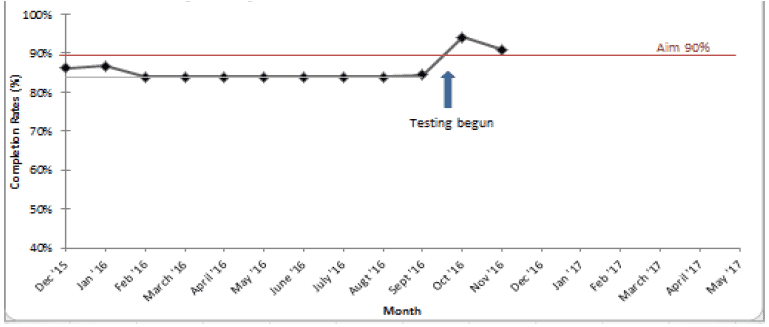
Disability Data Completion Rates in Division X
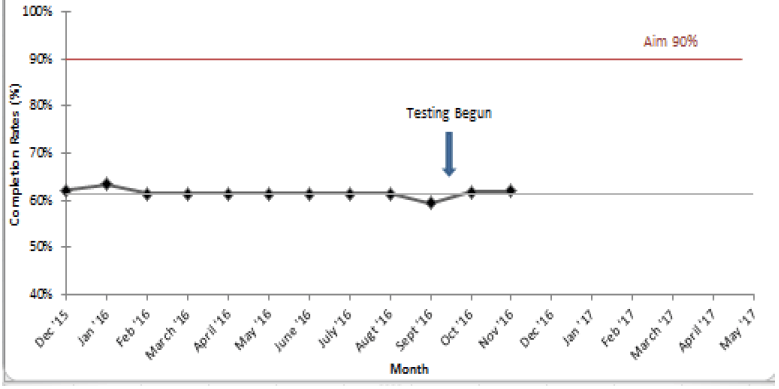
Sexual Orientation Completion Rates in Division X
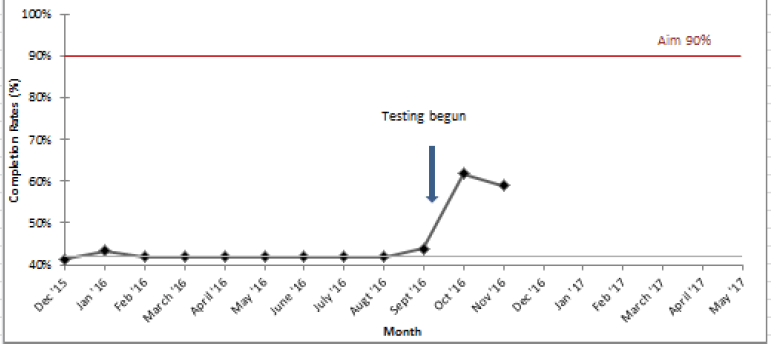
Religion/Belief Completion Rates in Division X
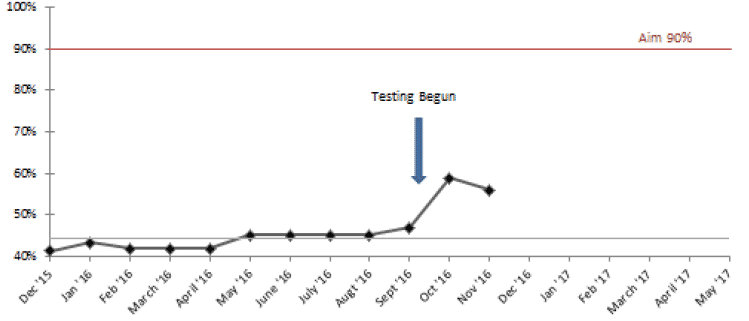
Completion Rates by Age trend, Jan 2013 - Dec 2016
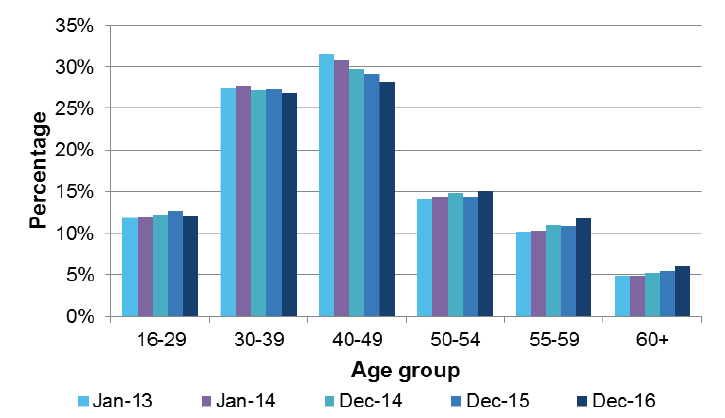
Completion Rates by Gender trend, Jan 2013 - Dec 2016
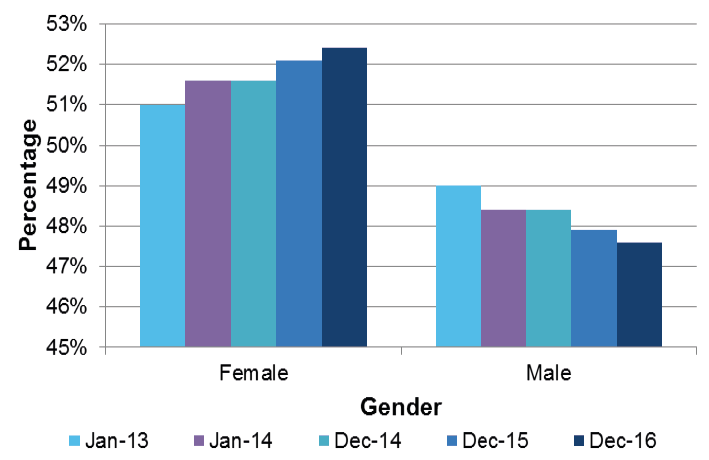
Ethnic group trend, Jan 2013 - Dec 2016
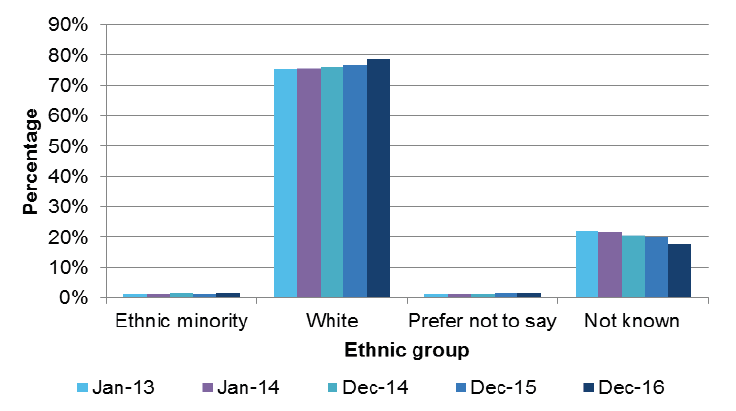
Sexual orientation trend, Jan 2013 - Dec 2016
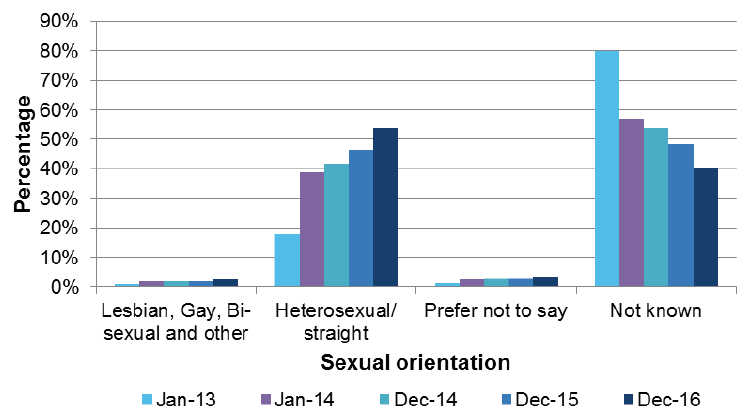
Moving towards a more representative workforce by 2025
What we achieved
We have seen an increase in women at Senior Civil Service ( SCS) level in Scottish Government core staffing, from 40 per cent in March 2015 to 45 per cent in September 2016.
What we did
We established the Public Boards and Corporate Diversity Programme ( PBCDPB), in early 2014, to improve diversity data across a range of areas. Although the initial focus of the Programme's work has been to improve the gender balance at all levels of the organisation, the project relating to Scottish Government's diversity of senior positions has longer term aspirations to increase representation of people at senior level across all protected characteristics.
Specific work on improving the diversity of our Band C and SCS staffing began in late 2014, focusing on how we improve and sustain the gender diversity of the organisation at that senior level, including our Non-Executive Directors.
We thoroughly monitored and reviewed our promotion and progression opportunities to ensure they are fair and transparent; this included a comprehensive evaluation of our promotion boards in 2012 and 2014.
Responding to evaluation of the 2014 Promotion Board we set up an Advisory Group with representation from across the Scottish Government and its delivery agencies, including our trades unions and experts in diversity analysis.
The Promotion Review Project carried out an extensive Equality Impact Assessment ( EQIA) on our approach to internal promotion, soliciting views in writing from staff diversity groups and following up with public meetings on how the proposed new promotion model would support increased diversity. The EQIA did not highlight any concerns that required adjustment to the new promotion model and it was implemented in October 2016. A robust evaluation strategy is in place to monitor the impact of the new promotion policy over the next 18 months.
In 2016 a key progression focus was an internal Deputy Director Promotion Board. As part of the preparatory work for the Promotion Board research was undertaken with the Scottish Government's staff diversity networks on the perceived barriers to applying for promotion to the SCS.
Some of the key messages from the research were: concerns around work life balance and alternative working patterns; a lack of diversity profiles in the SCS; limited dedicated time to prepare an application and for assessment centre; concern about the support available through the process including mock interviews and practice tests, and limited flexibility of assessment centre timings and location.
These helpful insights were used to inform the awareness sessions, which were held for Band C staff who were eligible to apply for the Board. The insights also informed the planning and literature for the Board process and for future recruitment and promotions to the SCS going forward. These included clear messages about the diverse groups of staff we were interested in attracting and clear messaging around flexible working.
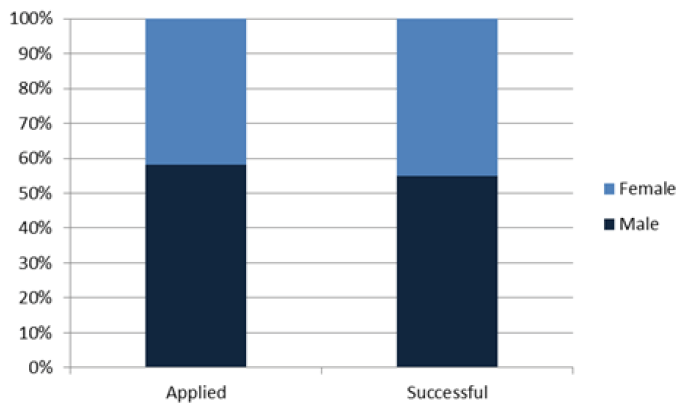
In 2016 the PBCDPB was dissolved and responsibility for the work moved to our People Board, to ensure that the work was mainstreamed through all of the Scottish Government's work.
Raising awareness of the Scottish Government as an employer and using positive action as appropriate to address under-representation
What we achieved
We have seen an increase in applications from BME candidates to our 2017 Graduate Development Programme ( GDP) up from 148 to 347 and the gender make up of Modern Apprentices ( MA) recruited since 1 April 2016 is reflective of the Scottish population - 51% female & 49% male
What we did
The Scottish Government has participated in various Whitehall and other external schemes aimed at bringing in and bringing on under-represented groups including the UK Civil Service Fast Stream. A recent review of the Fast Stream by the Bridge Group identified that the scheme had a particular challenge with socio-economic diversity. Changes have been made to the programme for 2017 to encourage a more diverse group of applicants and further work is on-going.
The Scottish Government's own GDP aims to identify individuals with the potential for senior leadership. Marketing for the second round in 2017 has targeted groups under-represented at senior levels in the organisation. The selection process for the current round of GDP recruitment has also been updated to reduce barriers and features positive action for minority ethnic and disabled candidates, and those who have experienced socio-economic disadvantage.
We have also worked with diversity networks to promote civil service high-potential development schemes to a wide range of applicants. For schemes starting in 2017 we have been committed to raising the diversity of participants and this has produced a more representative cohort. In particular, our approach to nominations raised awareness and offered encouragement to people from all backgrounds. Through selection, although our diversity data was suppressed due to low numbers (less than 5) we have at least 1 candidate in each of the protected characteristics and a gender split of 8 females and 7 males.
Since we established our Modern Apprenticeship Programme ( MAP) in April 2011, we have directly recruited 417 MAs to end of September 2016. The programme is targeted at unemployed and underemployed young people between the ages of 16 and 24. The gender make up of MA s recruited since 1 April 2016 is reflective of the Scottish population - 51% female & 49% male
We are also actively involved in Career Ready, a programme that prepares students for the world of work through a two-year mentoring programme, including paid internships and workplace visits; this programme is very much targeted at Social Mobility and Youth Opportunities.
Challenges
We have faced significant challenges while working towards achieving this outcome, including:
Limited external recruitment: Whilst the Scottish Government has been recruiting in small numbers, our corporate presumption against external recruitment has restricted the pace at which we have been able to influence change in the shape of our organisation. We are ensuring that we are making the most of recruitment opportunities through the MAP and GDP by actively reaching out to a wider group of candidates, improving our engagement with communities and reviewing and evaluating our processes.
The challenging time frame to deliver the target: Following a range of interventions, there has been progress in increasing the levels of staff providing diversity information, however this has been slower than predicted when the target was set. As stated previously this has been due to several challenges around IT compatibility, staff confidence and trust in how the information is handled, who has access to it and what it is used for.
Meaningful engagement
We want staff to provide diversity information because they want to, rather than it being seen as a tick box exercise. This has resulted in us taking actions focused on culture change and building trust and understanding, rather than a compulsory compliance approach. We acknowledge that this will mean progress may be slower but this approach will hopefully lead to higher levels of buy in and engagement. We also intend to share the learning from this work with the Scottish National Equality Improvement Project.
Equality and Diversity Matters - Scottish Government Directorates are by 2017 more confident in and better informed on equality and diversity matters and can engage with partners and stakeholders to effect change and improvement.
Those engaged in public policy should be confident in equality and diversity matters, and use this knowledge to design policies that meet the diverse needs of Scotland's population. It is important that we expand our knowledge on the issues and inequalities that affect different groups of people and that we feel confident in engaging with diverse communities.
As an employer, the Scottish Government seeks to create an environment for all individuals to thrive and to be successful. Promoting equality and diversity is a key aspect of this.
What we achieved
The results from our 2017 Staff Equality Survey were consistent with the 2015 results. However there were two questions which showed significant improvement between 2015 and 2017:
- An increase in staff awareness of our Equality Impact Assessment ( EQIA) tool from 52% in 2015 to 60% in 2017
- An increase in the proportion of staff who have undertaken equality-related training within the last two years, from 31% in 2015 to 38% in 2017
The improvement in staff undertaking training is important as staff who had undertaken training also responded more positively to a range of other questions, in comparison to staff who had not undertaken equality training. For example, they were more likely to:
- rate their understanding of equality concepts as 'good/very good'
- say that they were fairly/very confident in their knowledge of the types of issues which might be faced by certain groups
- say that they were broadly/fully aware of equality issues relevant to their work (87% vs. 80%)
- say that they were broadly/fully aware of statistics and data on equality for their policy area (42% vs. 28%)
- feel fairly/very confident in their knowledge of how to do an EQIA (39% vs. 31%)
- say that they were fairly/very confident in engaging with both equality communities (65% vs. 52%) and those with communication support needs and/or access issues (56% vs. 41%)
Summary of key findings from the 2017 survey:
- 86% rate their understanding of 'equality' as good/very good
- The proportion rating their confidence in the knowledge of issues faced by various groups as fairly/very confident ranges from 33% (for intersex) to 81% (for women)
- 83% consider themselves to be broadly/fully aware of equality issues relevant to their work and 33% for equality statistics and data
- 18% of staff have been involved in an EQIA in the last two years, and 34% of staff are fairly/very confident in their knowledge of how to do an EQIA
- staff are more likely to be aware of the EQIA tool and guidance (60%) than the Equality Evidence Finder (28%)
- 38% of staff had undertaken equality training within the last two years
- staff are more likely to say that they feel confident in organising meetings/events for different equalities communities (57%), than they are for stakeholders with communication support needs and /or access issues (47%)
What we did
The Scottish Government Staff Equality Survey
In early 2015 we conducted, for the very first time, a quantitative survey to measure SG staff confidence levels on equality concepts, issues for different equality groups and how confident people felt about engaging with different groups. Following the analysis of the survey results we held two focus groups. The focus groups explored barriers and enablers to participating in equality training and support required for completing equality impact assessments. The results have been informing a programme of work to raise knowledge/confidence levels of staff.
The Survey was repeated again in early 2017 to see whether there have been any changes to staff's knowledge levels. The results set out earlier will inform our work going forward.
Below are the findings from the 2017 Equality Survey, carried out with members of the Scottish Government People Panel, compared with 2015 results.
Proportion who are aware of the Equality Evidence Finder, by year
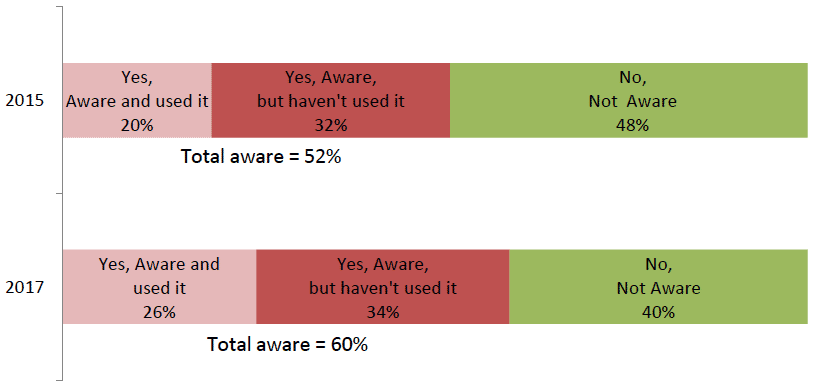
Proportion who have undertaken equality related training, by year
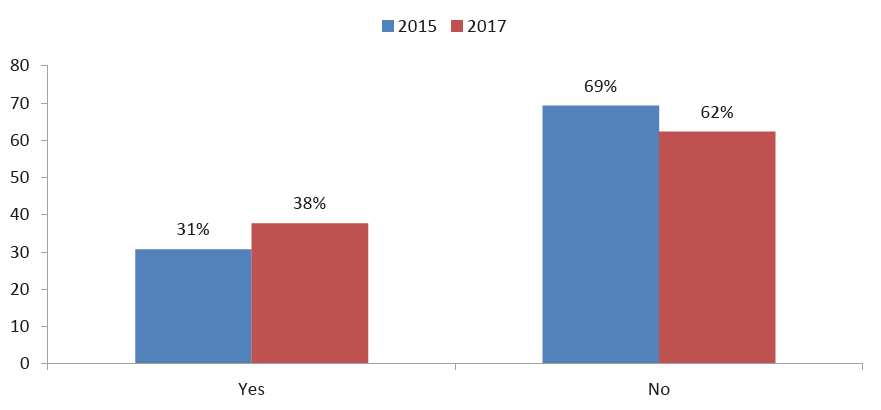
% SG staff responding positively to the Inclusion and Fair Treatment theme
Inclusion and Fair treatment 80%
Difference from previous survey 0
Difference from CS2016 +4
Difference from CS High Performers +1
Engagement by ethnicity, compared against UK Civil Service average
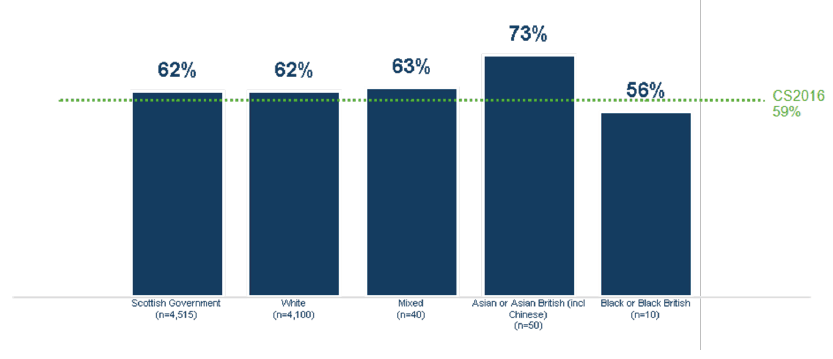
Engagement by sexuality, compared against UK Civil Service average
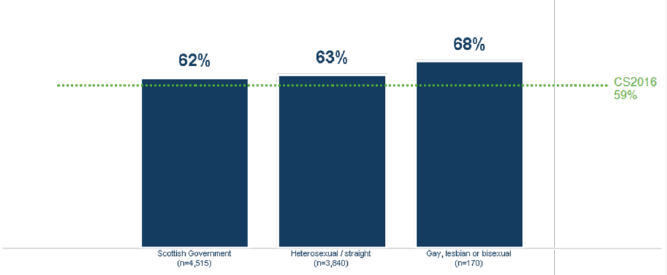
We are using People Survey results to inform a range of HR policies and initiatives
The People Survey is our annual corporate organisation-wide initiative seeking opinions from Scottish Government staff about work. The survey runs from 1 October to 31 October as part of the Civil Service People Survey conducted across 101 UK Civil Service Departments. It provides an opportunity to gain a good measure of the effectiveness of HR policies, in particular our Fairness at Work policy and our Flexible Working Policy. It also helps to establish how different groups of people feel in the organisation and their levels of engagement.
The detailed analysis and insights from the People Survey provide information on Employee Engagement, Inclusion and Fair Treatment, Wellbeing, Discrimination, Harassment and Bullying across grades, business areas and protected characteristics. The themes about which people are most positive include 'Inclusion and Fair Treatment'.
This analysis feeds into the annual evaluation of the People Strategy, informing priorities for the SG, as well as contributing to the Scottish Government's People Strategy Annual Report. Priority outcomes for the People Strategy were Leadership and Management, Building Capability, Wellbeing and Resilience.
The People Survey measures staff engagement, that is, how attached and proud people feel to be part of the organisation and how motivated and inspired they are to achieve its objectives. We know from the annual survey that some groups are less engaged in the workforce than others.
For example, colleagues who report they have a long-standing condition have a lower engagement score than the Scottish Government average, and across the survey themes, a less positive workplace experience in general.
In 2016 respondents who reported a disability had an engagement score of 59%. Those reporting that their disability impacted upon their daily activity 'a lot' had an engagement score of 52%. In contrast, LGB (68%) and BME (67%) respondents continue to have a higher percentage of positive engagement scores than SG average (62%).
Since 2009, responses to 'Inclusion and Fair Treatment' questions have been consistently high, with the positive score for the overall theme remaining at 80% in 2016. This is 4 percentage points above the UK Civil Service average and +1 above Civil Service High Performers, defined as the upper quartile across all organisations that have taken part. Indeed, when compared against Civil Service organisations of a similar size, Scottish Government comes out top for positive responses to the 'Inclusion and Fair Treatment' theme.
Our People Survey 2016 also indicated that 73% of our people agree that they are able to achieve good balance between their work life and their private life, and 87% say that their manager is considerate of their life outside work.
We are raising awareness of equality issues
Equality issues are regularly highlighted via Saltire (the Scottish Government intranet) articles, and a range of equality learning events has been made available for staff. Some of the learning events and initiatives have included:
- a series of transgender awareness sessions, in conjunction with the Scottish Transgender Alliance, tailored to specific policy areas
- Transgender-related information and statistics, have been expanded and made available on our intranet pages to help with, in particular, policy equality impact assessments
- the promotion of inclusive communication across the organisation, with inclusive communication being a cross-cutting theme in the Disability Action Plan. We have funded the development of an Inclusive Communication Hub, delivered jointly by Sense Scotland, Scottish Disability Equality Forum, Scottish Accessible Information Forum and Scottish Council on Deafness
- a series of British Sign Language ( BSL) awareness raising seminars
- a series of race equality awareness sessions, delivered by CEMVO
- the development of an e-learning module on Equality Impact Assessment to enhance our current EQIA training offer
- through our staff diversity networks, we have run various awareness raising sessions on the areas that staff have told us they are keen to know more about. These have included sessions on Asperger's, Alzheimer's, Flexible Working, Mental Health, and cancer awareness.
- we have appointed Scottish Government Executive Team and SCS Champions and Allies across all protected characteristics, to provide support to staff and to be the challenge to the organisation around that support for staff. The Allies and Champions are running a programme of events throughout 2016/17 around different protected characteristics to raise awareness of more under-represented groups
- our Allies are facilitating sessions to create more meaningful diversity objectives to help staff understand the challenges different colleagues face in the organisation and the role they can play in supporting them
- the information from the People Survey analysis is used to identify and assist business areas where the survey has shown potential issues of concern. Bespoke sessions are run to raise awareness of the policy and its application in the workplace. During 2014-15 and 2015-16 these have included sessions on Fairness at Work, Alternative Working Patterns and reasonable adjustments
Next Steps
- We will be undertaking a project to gauge the level of knowledge about HR policies and to better understand the issues on which our staff most regularly require information
- We will continue to engage with our staff diversity networks and in 2017 will hold sessions to gather their views on progress and what more we can do progress our ambitions around this outcome
- We will work with our staff networks and champions to build on better shape their operation and engagement
Public Appointments - Ministerial public appointments are more diverse reflecting broadly the general population by 2017
Public bodies make decisions which are of relevance and importance to communities across Scotland. Ministers make appointments to the Boards of many of these bodies and it is important that those serving come from the widest of backgrounds if those bodies are to have rounded and informed input and credibility across Scotland. Appointment is on merit but under-representation of a range of groups makes it likely that talent is being lost or being under-utilised.
Equality and diversity are key to Scotland's success. As a nation that prides itself on fairness, we seek to create equal opportunities for all regardless of gender, disability, ethnic background, age, religion/belief or sexual orientation. In the context of the boardroom, this means creating a culture and environment that enables us to harness the talents of everyone, enabling and promoting the participation in public and corporate life of people from under-represented groups.
There's also compelling evidence that having greater diversity of thinking and talent in the boardroom leads to better performance, encouraging new and innovative thinking, maximising use of talent and leading to better business decisions and governance. Increasing the talent pool available and supporting such participation leads to the creation of strengthened boards that are better able to understand consumer and community needs and deliver improved corporate governance. For our public bodies, this ultimately means improved public services that are high quality and value for money.
What we achieved
- We have significantly increased applications from women. The target set in the Commissioner's Diversity Delivers strategy is 40% - in 2016, 43% of our applications were from women
- In 2015, Ministers appointed more women than men for the first time: 54% of all new appointments went to women
- At the end of 2016, over 45% of all board positions were held by women
- Our advertising strategies are more targeted and we hold outreach events to challenge perceptions of traditional board members
We use an accessible core skills framework to develop person specifications to ensure that criteria do not inadvertently exclude any groups
We are working on a revised action plan which will encompass our work on broader protected characteristics. We have worked across Scottish Government to ensure we have actions linked to participation in public life in the Race Equality Framework, the BSL National Action Plan and the Disability Action Plan.
The table below sets out the comparison between the figures for the year to December 2016 compared to the figures for the year to January 2014:
| Regulated appointments | Year to 31 Jan 2014 | Year to 31 Dec 2015 | Year to 31 Dec 2016 | |||
|---|---|---|---|---|---|---|
| % | % | % | ||||
| Applicants | Appointed | Applicants | Appointed | Applicants | Appointed | |
| Women | 38.2 | 45.8 | 41 | 54 | 43 | 59 |
| Disabled people | 10.4 | 7.5 | 12.7 | 10.3 | 9.8 | 10.1 |
| Minority ethnic people** | 4.7 | * | 5.3 | 5.2 | 5.5 | * |
| Age under 50 | 29.8 | 24.9 | 27 | 25 | 27 | 31 |
| LGBO | 4 | * | 4.1 | 5 | 4 | 7.1 |
| Christian | 49.9 | 50.8 | |
|
47 | 52.6 |
| Non-Christian | 3.5 | * | 3.7 | 3.1 | 4.7 | * |
*Values for less than 5 have been supressed to decrease the risk of disclosure of information about individuals.
** 'Minority ethnic' covers the non-white broad ethnic groups: African, Caribbean or Black; Asian, Asian Scottish and Asian British; mixed or multiple ethnic group; other ethnic group.
These figures demonstrate a significant increase in both applications from and appointments of women helping to increase the gender diversity of Ministerial public appointments. 2015 was the historic first year in which more women than men were appointed to the boards of public bodies.
We note that although the number of applications from people under 50 has slightly decreased, there has been a 6% increase in appointments to people under 50, and while the number of applications from LGBO people has remained static, there has been an increase of more than 2% in appointments.
Conversely, we note in particular the drop in applications from disabled people, and relatively static number of appointments. We have started to engage with representative organisations to understand where the real and perceived barriers in the process are, and to plan a targeted outreach programme. We also have actions in A Fairer Scotland for Disabled People and the draft BSL National Plan.
It is important to recognise that progress towards greater diversity in public appointments must be measured over a long period to establish a trend, as year on year figures may not present a complete picture.
This is for a variety of reasons, for example: the number of rounds and vacancies to be filled fluctuates from year to year; the types of bodies to which appointments are made does not follow a standard pattern from year to year; the nature of individual appointments varies from round to round; and decisions may be taken to reappoint or extend existing members rather than undertake new appointment rounds.
Testimonial from the Commissioner for Ethical Standards in Public Life in Scotland
"I welcome the public appointments team's willingness to continue to work constructively with my office towards our shared aim of effective boards, reflective of society. This has led to some significant progress over the past two years. Early engagement with public appointments advisers and a new attitude to discussion of issues has allowed for innovation in planning for appointments and in the methods used. Crucially, there has been better dialogue with ministers around the definition of merit in the context of the future requirements of boards. As well as system improvements, we have been jointly engaged in outreach events and in further developing the strategic approach to addressing diversity issues and securing the best people to serve on boards.
For the next two years we will continue to capitalise on the welcome openness in the relationship between the practitioners and the regulator with a view to making further progress, particularly in respect of improving lessons learned methodology, succession planning and the role of boards themselves in securing and harnessing diversity. We have specific research planned, involving the public appointments team, public bodies unit and boards themselves, intended to assist in achieving these latter two aims. Taken together these measures will, it is anticipated, assist us in redressing underrepresentation in those areas in which the progress has been less marked."
What we did
From first principles, Public Appointments are made on merit within a system founded on integrity which promotes diversity: with those principles at the heart of our drive for change, and scrutinising all aspects of the process, we devised actions to bring diversity, with an early focus on gender balance, to public body boardrooms.
We engaged Ministers at the outset of competitions to establish their vision for new appointees, encouraging the definition of merit in creative rather than traditional terms. We've worked with groups representing those with protected characteristics to identify barriers to participation and develop solutions. We developed an outreach and awareness programme, raising the profile of public appointments and using role models to help potential applicants envisage themselves in boardrooms.
We are building the capacity of boards themselves by offering induction and development sessions supported by peer learning and mentoring opportunities. We continuously test, evaluate and refine our processes, recycling our learning, sharing good practice, and using the rich data we generate within rounds to track and measure our progress.
Testing, evaluating and refining the public appointments process
We have been driving a range of improvements to the public appointments process to ensure that we reach out to the broadest range of potential talent and bring this talent to the boardroom of Scotland's public bodies. Those activities include:
Engaging with Ministers in a different way to support them in specifying their requirements for skills, experience and attributes for board members
The principle of appointing on merit, as set out in the Commissioner's Code of Practice for regulated ministerial public appointments, requires that where one candidate best meets the selection criteria as set out in the person specification then only that candidate is recommended to Scottish Ministers for appointment, ensuring the integrity and transparency of the process. We have been encouraging the definition of merit in creative rather than traditional terms: for example, the Minister for Public Health specified 'an understanding that social change can be achieved through sport' for the chair of sportscotland - we recruited the founder of the Homeless World Cup.
Developing a new core skills framework for chairs and members
The new core skills framework includes many of the generic skills / personal qualities which may be sought as part of public appointment rounds across the diverse range of bodies and organisations in Scotland. Each of the skills/qualities is defined at three different levels and includes descriptors of what applicants will be expected to demonstrate at each level. The panel select the level which best describes the skills/personal qualities which are needed and can adapt the descriptors - or add their own - in order to make them more specific and relevant. The skills and descriptors form the basis of the Person Specification which is provided to applicants to ensure they are fully aware of what they will need to demonstrate, and used by the panel to evaluate the evidence provided at the different stages of assessment.
Sharing what does and doesn't work in recruiting candidates for effective, diverse boards
This Creative Scotland case study shows how we combine new and different approaches to deliver results.
Your creative insight will inform the future of the arts
An early pilot where new, creative approaches were tested, was the appointment round for board members for Creative Scotland which began in spring 2015. Aspects of this round that were approached rather differently were as follows:
The Cabinet Secretary for Culture, Europe and External Affairs took part in a discussion with senior sponsors, the board chair, the Public Appointments Team and an Adviser from the Commissioner for Ethical Standards in Public Life in Scotland's team, to identify what the particular skills, experience and personal qualities were required that would reflect her future vision for the Creative Scotland board and align with forthcoming business.
This led to the development of a less traditional selection criterion as follows:
Enthusiastic and passionate about arts & culture in Scotland
- knowledge/understanding of arts and culture in Scotland and the role of Creative Scotland
- regularly attend arts/cultural events
- able to explain how the arts/culture have benefited yourself and how they can benefit the wider community
- can enthuse others about the arts/culture
- The new core skills framework for board members was trialled, describing selection criteria in inclusive language and setting out clearly for applicants what would be tested and how. This is now in regular use.
- To complement the competency based aspect of the interview, a board paper exercise was used to allow candidates to demonstrate their skills. Candidates were asked to review a mock board paper which was then discussed at the start of the interview.
- Advertising was via a social media package which included reaching out to passive candidates (i.e. those not actively seeking a position) or those who may not have considered that a public appointment was a potential opportunity for them. It was headline driven rather than job description driven: Your creative insight will inform the future of the arts
Outcomes - We received 30 applications, with 18 from women and 12 from men, and 21 of the applicants had never held a public appointment before. There were four successful candidates with a gender split of 3 women and 1 man and the board achieved a gender balance as a result.
Working with groups representing those with protected characteristics and developing an outreach and awareness programme
We have worked with a number of organisations including CEMVO and PATH Scotland to raise the profile of public appointments with minority ethnic people, and understand where barriers to participation might lie.
In terms of gender, we have delivered events and seminars with partners including Women in Agriculture, Women in Public Service Leadership and Equate Scotland.
To ensure that applications come from people with a wide range of backgrounds, we've been part of exhibitions at The Gathering, the Institute of Directors conference and Women in Business, and in the last year we've held awareness events for specific appointment rounds for NHS Greater Glasgow and Clyde, the Mobility and Access Committee for Scotland and the Scottish Housing Regulator.
A key part of our outreach strategy has been our 'Come on Board' programme.
We delivered Come on Board in partnership with Changing the Chemistry. Over 2016, we held 4 evening events - 2 in Edinburgh and 2 in Glasgow - connecting with over 250 potential new board members.
We used these sessions to demystify the appointment process. We covered the benefits of being on a board; the support and help available and the appointment process for public sector boards. We involved existing board members as role models, sharing their personal journeys to the boardroom, and invited board Chairs to 'sell' their board in particular.
The events were a great success with over 75% of attendees saying they are now more likely to apply for a Public Appointment. In fact one of the attendees at our first event was inspired to apply, successful in her application and returned to share her personal journey at our third event.
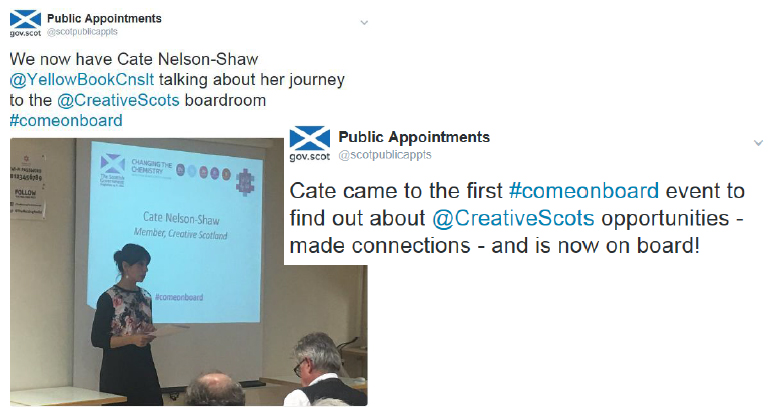
Building the capacity of boards
As we are now starting to see new and different people being appointed, we need to support them effectively as they step into their roles, and develop their understanding of where they fit in the bigger picture. These are the drivers behind our new Scottish Government board member induction workshop which complements board-specific induction activity. Three times per year we will gather together all new appointees for a day to hear from a Minister, Audit Scotland, the Commissioner for Ethical Standards and Scottish Government staff, and we will support attendees to form their own peer network. We are also delivering a range of activity to support board development, including workshops for Chairs to explore issues including succession planning, board development and diversity
Challenges
With the initial focus on gender, there is more still to do on addressing representation amongst other protected characteristics (particularly disabled people and people under the age of 50), and to addressing more generally diversity in those appointed to Chair roles. We use a lessons learned process to ensure the systematic sharing of good practice, and we have begun working with a range of equalities stakeholders to identify barriers to participation and solutions.
Next steps
Given our success on improving gender diversity, we are applying our learning to address other underrepresentation. We have refreshed and broadened out our Improvement Programme, and already have some actions underway and others in the planning stages, working with groups representing those with protected characteristics, to identify barriers and develop solutions. Priorities include improving the representation of disabled people on our boards, increasing the number of applications from younger people and improving the representation of all the protected characteristics in chair roles.
Violence Against Women - Progress is made towards the reduction in violence against women by 2017 through a strategic and co-ordinated approach by agencies and women's organisations
Violence against women and girls is a violation of human rights. It damages women's and girls' health and well-being, limits their freedom and potential, and causes wide-ranging negative impacts on our society. The Scottish Government is unequivocal - violence against women and girls in any form, has no place in the strong and flourishing Scotland we all want to see.
Equally Safe, Scotland's Strategy to prevent and eradicate all forms of violence against women and girls was published in 2014 and updated in 2016. It is a joint Strategy developed by the Scottish Government and CoSLA (along with key stakeholders), and it sets out a vision of a strong and flourishing Scotland where all individuals are equally safe and respected, and where women and girls live free from all forms of violence and abuse - and the attitudes that help perpetuate it. Our aim is to work collaboratively with key partners in the public, private and third sectors to prevent and eradicate all forms of violence against women and girls.
We have continued to draft the delivery plan, and published this for consultation on 23 March 2017.
What we achieved
We have a range of evidence sources to inform our interventions and understanding of the current position and progress towards our goals:
- In 2014/2015 there were 59,882 recorded incidents of domestic abuse. This decreased by 3% to 58,104 recorded incidents in 2015/2016. The disproportionate impact on women has remained consistent, with 79% of incidents involving a female victim and male perpetrator.
- In 2014/2015 there were 1797 recorded incidents of rape and 104 recorded incidents of attempted rape. In 2015/2016 there were 1692 recorded incidents of rape and 117 incidents of attempted rape. There were 3727 recorded incidents of sexual assault in 2014/2015 compared with 3963 incidents in 2015/2016. In 2014/2015 there were 3555 recorded incidents of other sexual crimes compared with 4254 recorded incidents in 2015/2016.
- 646 non-harassment orders (civil and criminal) were granted in 2014/2015 compared to 941 in 2015/2016.
- In 2015 the UK National Referral Mechanism received 145 referrals of potential victims of human trafficking in Scotland, an increase of 30.6% on 2014. 42 of these potential victims were minors. Victims trafficked for sexual exploitation included 40 adults and 8 minors, both predominantly female.
- The 2014 social attitudes survey on public attitudes towards violence against women findings tell us that people are less likely to recognise verbal abuse and controlling behaviour (as opposed to physical abuse) as being wrong and harmful, and there are circumstances under which people view abusive behaviours as less serious (e.g. an extramarital affair has occurred). People tend to think that sex without consent is less seriously wrong or harmful if perpetrated by the victim's spouse than by someone she has just met. More than a third of people believe common myths about rape, and people are much less likely to be negative about commercial sexual exploitation than about the other forms of violence against women. Stereotypical views on gender roles persist, and those who held stereotypical views on gender roles are consistently less likely to view a wide range of abusive behaviours as wrong or harmful.
- Attitudes of young people showed they were less likely than adults to think the various kinds of violence against women that they were asked about were very seriously wrong, or to think that they would cause a great deal of harm. In some cases, the extent to which young people appear to hold more permissive views than adults about violence against women is striking. Stereotypical gender views played a role in this.
It is challenging to draw conclusions on progress made towards our goal, given that this violence overwhelmingly remains hidden and underreported. Our challenge going forward will be in continuing to increase confidence in reporting and shift public attitudes so that gender based violence is increasingly recognised by wider society as unacceptable.
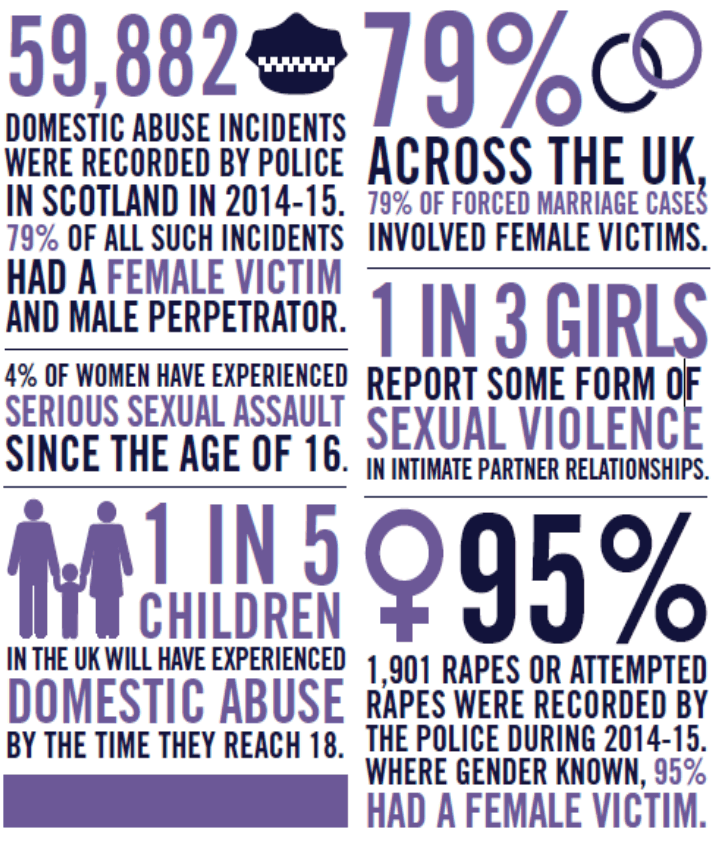
What we did
- The establishment of a Joint Strategic Board, co-chaired by the Equalities Secretary and the CoSLA Community Wellbeing spokesperson and comprising senior cross-sectoral leaders
- The establishment of workstreams focusing on primary prevention of violence, building the capability and capacity of mainstream and specialist services to support survivors, strengthen the justice response to victims and perpetrators and embed accountability.
- Record levels of funding to tackle violence against women and girls - in addition to over £24m (2015-17), the First Minister committed an additional £20m from the Justice budget over 2015-18. This has supported a range of initiatives, including improving access to justice, direct specialist service delivery for women and children experiencing violence and abuse, prevention projects and research into various issues including advocacy provision.
- The passing and commencement of the Abusive Behaviour and Sexual Harm (Scotland) Act 2015, which criminalises so called 'revenge porn', provides for jury direction on consideration of evidence in cases of sexual assault and creates a specific aggravation of domestic abuse in law.
- Policy development of a new criminal offence of domestic abuse with a draft Domestic Abuse (Scotland) Bill in March 2017
- The publication of Scotland's first National Action Plan to tackle female genital mutilation in February 2016.
- The publication of research into Forced Marriage in Scotland in February 2017.
- The publication of updated guidance in 2016 to support the more effective working of local Violence against Women Multi-Agency Partnerships.
- Evaluation of the Caledonian System Men's Programme which will inform our thinking on next steps to tackle perpetrators through interventions.
- The publication of a draft delivery plan in March 2017 which includes a draft suite of outcomes and indicators to measure progress.
We will bring forward delivery plans for Equally Safe to set out clearly how we intend to work towards preventing and eradicating all forms of violence against women and girls over the lifetime of this Parliament.
A range of specific actions planned are detailed within the draft delivery plan which can be located at http://www.gov.scot/Publications/2017/04/6896.
Gypsy/Travellers experience less discrimination and more positive attitudes towards their culture and way of life by 2017
Gypsy/Travellers have limited voice and influence in the public policies which affect them. The 2010 Scottish Social Attitudes Survey Attitudes to Discrimination and Positive Action module concluded that Gypsy/Travellers are the subject of widespread discriminatory attitudes. Successive reports from the Equal Opportunities Committee of the Scottish Parliament have highlighted the difficulties in accessing services and discrimination experienced by Gypsy/Travellers.
What we achieved
The 2015 Social Attitudes Survey showed a reduction in discriminatory attitudes amongst the general public towards Gypsy/Travellers.
What we did
The Scottish Government has developed a revised peer review process for Local Housing Strategies, in agreement with COSLA and ALACHO, that will run for the next three or four years (2015 - 2018/19). This process will help to ensure, through highlighting areas for improvement and good practice, that accommodation and accommodation-related needs of Gypsy/Travellers are taken into account by local authorities, as they plan housing provision in their areas. The new Local Housing Strategy guidance was published on 21 August 2014.
In May 2015, Scottish Government published "Improving Gypsy/Traveller Sites' guidance on minimum quality standards and core rights and responsibilities for Gypsy/Travellers living on sites.
Published Gypsy/Travellers in Scotland - A Comprehensive Analysis of the 2011 Census on 15 December 2015. This report brings together analysis previously published to provide a comprehensive and wide ranging evidence base on Scotland's Gypsy/Travellers.
We established the Gypsy/Traveller Site Working Group. This brought together representatives of the police, local authorities, and those with close links to the Gypsy/Traveller community, to consider ways forward on issues around Gypsy/Traveller sites. It completed its work in November 2014.
Funded Planning Aid Scotland ( PAS) to carry out a project on planning and the Gypsy/Travellers community. As part of this project PAS produced guides on the planning system and the Gypsy/Traveller community for councillors, community councils, and Gypsy/Travellers. The guides were launched in April 2015.
From 2012-15, the Scottish Government's Equality Fund provided funding of just over £600,000 to organisations working to develop projects specifically targeting the Gypsy/Traveller community. In 2016/17, the Equality Fund has allocated over £200,000 to fund organisations working with the Gypsy/Traveller community.
The Scottish Government will monitor the impact the 'Improving Gypsy/Traveller Sites' guidance on minimum quality standards and core rights and responsibilities for Gypsy/Travellers living on sites, which was published in May 2015.
We will engage directly with members of the Gypsy/Traveller community on a strategic programme of work and set out our progress and future plans in 2017.
The Scottish Government has undertaken to review the current guidance on managing unauthorised sites, which was published on 5 April 2017 The guidance will support effective approaches to managing unauthorised sites, through the provision of advice and examples of good practice
Through the Scottish Traveller Review Group ( STERG), the Scottish Government have developed guidance to improve the educational outcomes of Gypsy/Traveller children and young people, which is currently open to public consultation until 28 May 2017.
Challenges
SG was working to develop an overarching strategy and action plan for Gypsy/Travellers. Work was overseen by the Gypsy/Traveller Strategy Development Group that met throughout 2014 and into 2015. The last meeting was on 10 August 2015.
The work of the Group progressed well, and it considered a range of issues affecting Gypsy/Travellers in Scotland including education, health and accommodation. This led to the development of a draft action plan, which would form a key part of the strategy. However, some differences in the views of Group members emerged in relation to some aspects of the action plan, which required further consideration. Work on the strategy was therefore paused.
Women and Employment Women's position in the economy and in employment is improved in the long term and reflected more comprehensively in Scottish Government economic policy and strategies by 2017
In April 2013, women's position in the economy and in employment was identified as a Scottish Government equality outcome for two key reasons, a commitment to women's equality and economic imperative.
Women are crucial to maintaining a strong and healthy economy, a fact clearly reflected in Scotland's Economic Strategy which said "maximising economic opportunities for women to participate fully in the economy, and recognising the wider social role they provide, is key to improving economic performance and tackling inequality". And yet, women's interaction with the labour market is often categorised by inequality. Inequality which not only inhibits individual women's earnings, but prevents our economy from being as strong as it could be.
Women are more likely than men to be employed in lower skilled jobs, more likely to work part time, and more likely to be underemployed. In 2016, the pay gap between men and women employed full-time was 6.2%. The gender pay gap for all workers, including full time and part time is larger, at 15.6%, reflecting the fact that more women than men work part time.
The fact that women are more likely to assume responsibility for the larger share of childcare and other caring responsibilities, such as for elderly relatives, and to make adjustments to their working arrangements to accommodate these responsibilities, remains arguably the most significant driver of the gender pay gap and of differences in women's and men's employment. Evidence suggests that this is exacerbated by a lack of good quality, flexible, and part time working opportunities, leading to some women working in jobs that do not reflect their level of skills and qualifications.
Since 2013, considerable focus has been given to reflecting women's position more comprehensively in Scottish Government economic policy and strategies, and to tackling the inequalities which categorise women's interaction with the labour market. Positively, the full time gender pay gap in Scotland is at an historic low and employment rates for women continue to compare favourably with the UK.
But undoubtedly inequality for women in the economy and in employment persists, requiring sustained commitment and a long-term approach from Scottish Government, employers and others to address.
It is also important to recognise that overall trends can mask considerable differences for different groups of women, including older women, ethnic minority women, and disabled women, and that targeted interventions are likely to be needed.
What we achieved
In 2013, two key indicators were identified to measure long-term progress: the gender pay gap in Scotland, and employment rates for women.
Gender Pay Gap
The gender pay gap describes the difference in average pay between men and women. There are different ways to measure the gender pay gap. The 'official' measure used by the Office of National Statistics is the difference between full-time gross median hourly earnings (excluding overtime). Since 1997, the full-time gender pay gap in Scotland has decreased considerably from 18.4% in 1997 to 6.2% in 2016.
The overall pay gap, 15.6% in Scotland in 2016, includes both full time and part time workers and is larger than the full time gap because part time workers tend to be paid less on average and there are a higher proportion of female part time workers. In addition some stakeholder organisations prefer to use the mean rather than the median when calculating the pay gap.
Across all measurements, when women and men are compared, women earn less, on average, than men per hour worked. Since 1997, the gender pay gap has declined significantly. This is true for both the full time pay gap and the overall pay gap. The gender pay gap in Scotland is consistently below that of the UK as a whole.
Chart: Full time and overall gender pay gap, Scotland and UK (Median hourly earnings excluding overtime)
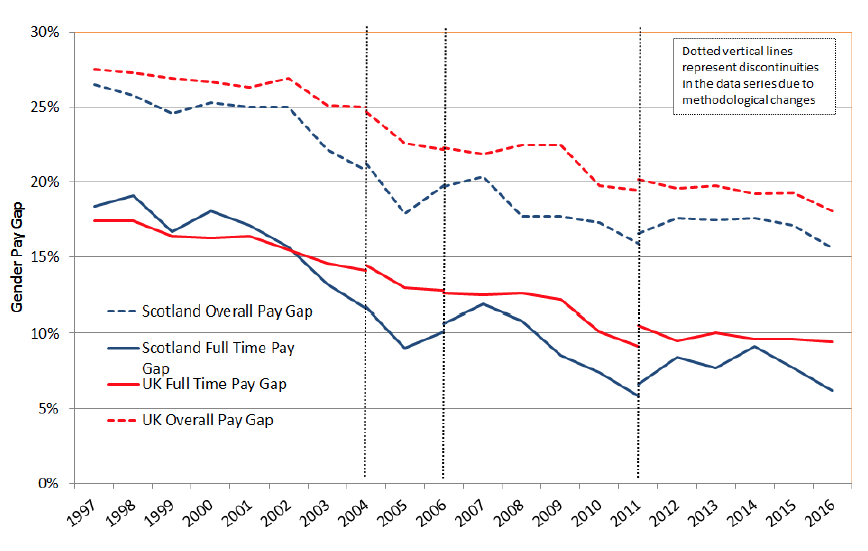
Source: Annual Survey of Hours and Earnings, ONS (Note: Median hourly earnings, excluding over time)
However, headline statistics do hide significant differences in relation to sectors and age groups. The Scottish Government bulletin ' The Gender Pay Gap in Scotland - 2016 Update and Analysis of Time Series Data' looks at the headline statistics and breaks these down by age, occupation, industry and UK countries.
In addition, the Scottish Government report ' New Perspectives on the Gender Pay Gap' explored the impact of occupational and industry segregation on the gender pay gap, finding the gender pay gap to be much higher in certain sectors - professional, scientific and technical activities, financial services and manufacturing being notable examples.
The gender pay gap exists for a number of complex and interrelating factors. In addition to the impact of caring responsibilities, gender stereotypes about the kinds of work that men and women do is also a significant factor, while evidence published by the Equality and Human Rights Commission in 2015 highlighted that pregnancy and maternity discrimination remains an issue.
Women's Employment Rates
The female employment rate is 70.1% in Scotland, higher than the UK rate of 69.9%. Scotland also outperforms the UK on the female labour market participation rate [1] (73.5%, compared to 73.3%).
Based on the most recent available data, Scotland has the second lowest female unemployment rate (15-74) at 4.4%. Over the most recent year, the female employment level in Scotland decrease by 6,000 over the year 1,261,000 [2]
Male and female employment rates for Scotland and UK, 1997 - 2017
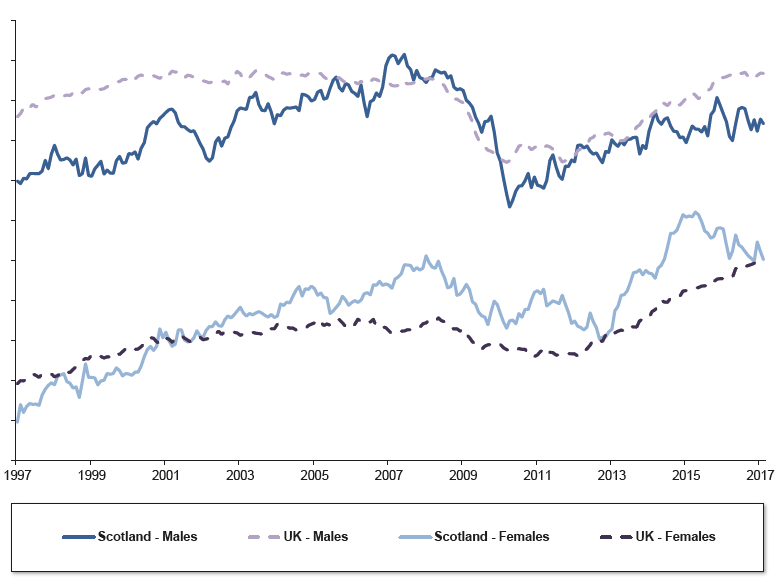
What we did
Between April 2013 and this, our final report on progress, a range of activity has contributed towards positive change. Some of this activity was described in our report on progress as part of the Scottish Government Equality Outcomes and Mainstreaming Report 2015, and will continue to form part of a suite of initiatives to address women's inequality in relation to work:
- The Scottish Business Pledge
- The Fair Work Convention
- The Partnership for Change 50/50 by 2020 campaign
- Women in Enterprise Action Framework
Other activity is newer and will play an important role in our work to support women's equality in relation to the economy and employment going forward.
Our plan to nearly double free early learning and childcare entitlement for all 3 and 4 year olds as well as eligible two year olds (around a quarter) to 1140 hours per year by 2020 remains our single most transformative infrastructure project. The OECD and EU have stressed the importance of early learning and childcare in removing barriers to female labour market participation, highlighting that early learning and childcare constraints play an important role in parents' work decisions, and that provision of more comprehensive early learning and childcare helps remove barriers to employment.
We will also continue to work with organisations such as: Family Friendly Working Scotland Partnership; Working Families; Parenting Across Scotland, and Fathers Network Scotland to support and promote the development of family friendly workplaces across Scotland.
Other initiatives intended to help improve women's position in relation to the economy and employment include:
- A new Pregnancy and Maternity Working Group, chaired by the Minister for Employability and Training to improve employers' and pregnant women and new mothers' access to advice and create new guidelines for employers to promote good practice. This follows Equality and Human Rights Commission research published in 2015 which found that 11% of women interviewed reported having been dismissed, made compulsorily redundant, or felt that they had to leave their jobs when they were pregnant or on maternity leave.
- A Women Returners Project, delivered by Equate Scotland with funding from the Scottish Government, to support women to return to the workplace after a career break. This 12-month project will provide 40 women with support to re-enter the STEM sector by offering one to one guidance, career clinics and access to webinars and three month placements. The placements will focus on life sciences, digital skills and engineering. We will also develop returner programmes in other industrial sectors where women experience barriers to re-entry e.g. financial services. Further funding of up to £200,000 will support the expansion of the Women Returners Project to additional sectors including manufacturing and financial services.
- As part of our work to challenge gender stereotypes and occupational segregation our STEM strategy will seek to inspire more young girls to consider a career in STEM, as well as addressing the factors which result in qualified women dropping out of STEM sectors and careers.
- An additional £200,000 in 2016/17 to address the gender gap in enterprise. Funding will help to support Women Enterprise Scotland to deliver the internationally recognised Women In Enterprise Ambassadors Programme and a project led by Investing Women to enable female-led businesses to become investment-ready and bring them together with female investors.
- A commitment to publish a gender index in Spring 2017 which will bring together key indicators of gender equality across the economy and wider society. As part of this work we will develop an approach to data collection which enables the capture of data on the utilisation of resources and time in Scottish households by gender. This was recognised in April 2013 as a vital missing piece of evidence to help to reflect the significant contribution that women make to the economy through unpaid work, including care, in addition to paid employment. We are also working with stakeholders to produce an Equality Evidence Strategy for the period of this parliament, setting out how we are going to improve equality evidence and analysis in Scotland.
- The Minority Ethnic Women's Network has been established, with events taking place in 2017 to link in to the Scottish Government's Race Equality Framework actions. The first event was held on 22 February 2017, with over 90 women attending. As well as looking at the vision, purpose and structure of the network, the members discussed the issues they faced in the workplace, with potential solutions also identified. These will be fed into the ongoing implementation of the Race Equality Framework.
Going Forward
Positive progress has and continues to be made to improve women's position in the economy and in employment. The long terms trends in relation to both the gender pay gap and women's employment are positive, though year on year figures are more volatile and often hide significant differences, particularly for different age groups and sectors. The Scottish Government recognises that in order to achieve further improvement, sustained commitment, focus and energy is needed, not just from the Scottish Government but from employers and others too.
Further Reading
There are a number of other Scottish Government publications which are relevant to the Scottish Government's work to understand the barriers for and improve the position of women in the labour market. These include:
- The Gender Pay Gap in Scotland - Update and Analysis of Time-Series Data
- New Perspectives on the Gender Pay Gap
- Race Equality Framework for Scotland
- A Fairer Scotland for Disabled People - Delivery Plan
Disability and Access to Justice and Advice - Disabled people have improved access to justice and to advice in relation to their rights by 2017
In April 2013, 'Disability and Access to Justice and Advice' was identified as a Scottish Government equality outcome because evidence indicated that disabled people were facing multiple barriers to exercising their rights through Scotland's justice system. The barriers identified in the Access to Justice Report 2010 included: difficulty in physically accessing buildings and appropriate advice and information; communication issues, and negative attitudes and stereotypes.
What we achieved
Through the framework provided by the Strategy for Justice in Scotland and under the leadership of the Justice Board a range of activity has aimed to improve disabled people's experience of the justice system and to tackle the multiple barriers experienced. A comprehensive overview of the key actions taken to April 2015 were set out in the Scottish Government Equality Outcomes and Mainstreaming Report 2015. They include:
- The creation of the Criminal Justice Project Team following the publication of Access to Justice in 2010, tasked with increasing access to criminal justice for disabled people
- The Justice Digital Strategy - an ambitious programme to use digital technology to transform the way justice is delivered, including the use of video conferencing throughout the justice system which will benefit disabled people and those who live in institutions and rural areas
- A range of activity to raise awareness and increase reporting of disability hate crime, including: the Scottish Government's first hate crime publicity campaign in 2014, and funding of £180,000 in 2012-15 to raise awareness and improve reporting of hate crime within the deaf community
Key achievements to date in addition to 2015
Since April 2015 further positive progress has been made.
- All criminal justice front facing reception points display a poster which encourages service users that reasonable adjustments are available to remove barriers to the services provided. A pack has been prepared for reception staff to support them in delivering these adjustments and this is being implemented across organisations
- On-going site audits and improvements, including the introduction of new and improved Hearing Loop Systems in Crown Office and Procurator Fiscal Service sites
- Easy Read versions of core documentation have been created and are available on internet sites. Word format versions are also now available to supplement the PDF format versions
- Improved co-ordination of hate crime campaigns across criminal justice to focus on an integrated message. A review of the use of 3 rd party reporting has been completed and improvements are being made to provide a more linked up service
- Guidance for solicitors to assist them in recognising the additional needs of clients with a disability and additional training provided, for example, deaf awareness training for all criminal justice staff has been provided.
Scottish Legal Aid Board Grant Funded Projects
The Scottish Legal Aid Board ( SLAB) administers a number of grant-funding programmes on behalf of the Scottish Government and the Money Advice Service. There are three overarching programmes - Economic Downturn, Making Advice Work, and Tackling Money Worries.
The Making Advice Work ( MAW) programme supports advice provision for people affected by the UK Government's welfare reforms, under which there are three streams of activity. Stream 3 of this programme in particular seeks to extend the availability of advice to the most vulnerable groups, particularly disabled people and victims of domestic abuse.
The Tackling Money Worries ( TMW) programme seeks to tackle the unmet debt and financial capability needs of low-income families.
Across MAW3 and TMW, the Scottish Legal Aid Board funds 6 specific projects that focus their remit on providing their advice to those with a physical and mental health disability, covering the local authorities of Lanarkshire (North and South), Glasgow, Edinburgh, the Lothians, and Falkirk.
A Fairer Scotland for Disabled People: Our Delivery Plan to 2021
Individual and collective rights are only worthwhile when they can be exercised. While positive progress has been made since 2013 to improve disabled people's access to justice and advice, the Scottish Government recognises that more needs to be done to ensure that this is a reality for disabled people in Scotland. In December 2016, the Scottish Government published A Fairer Scotland for Disabled People: Our Delivery Plan to 2021 for the United Nations Convention on the Rights of Persons with Disabilities.
Ensuring that the rights of disabled people are fully protected and they receive fair treatment from the justice system at all times, is one of five long-term ambitions of the delivery plan aimed at changing the lives of disabled people in Scotland and ensuring that their human rights are realised. We want disabled people to be treated as equal citizens within all elements of the justice and tribunal system, with full access to the physical environment, advocacy and support, information and advice, and communication support. This ambition is underpinned by 9 actions:
- Fees for employment tribunals will be abolished, when we are clear on how the transfer of powers and responsibilities will work. We will consult with disabled people and other equality groups to identify the particular barriers that they face when raising a claim at an Employment Tribunal
- We will work with disabled people's organisations and Police Scotland to encourage greater reporting of disability hate crimes and to further the implementation of the recommendations of the Independent Advisory Group on Hate Crime, Prejudice and Community Cohesion
- As part of the process of implementing Equally Safe, our strategy to prevent and eradicate violence against women and girls, we will engage with the disabled people's panel to identify specific actions to support disabled women and girls who experience gender-based violence
- We will work together to explore how the justice system could better understand and respond to individuals with autism as they interact as witnesses, victims, suspects or offenders
- We will work with partners, including disabled people and the organisations that represent them, to identify negative impacts on disabled people of the current legal aid framework for contributions and develop options for change and make any legislative changes required
- From 2016, the seven main criminal justice organisations will publish their most important pieces of information in alternative formats. An online secure website will be developed to provide fully-accessible case information for victims and witnesses
- The seven main criminal justice organisations will carry out site audits of their buildings to identify any physical access barriers that need to be removed. This information will be available on each organisation's website from 2016
- We will continue to work with the Law Society of Scotland to encourage the promotion of specialism in disability discrimination law and will promote awareness of such activity
- The Scottish Fire and Rescue Service ( SFRS) recognises that those most vulnerable to fires are predominately elderly individuals or people with significant health or mobility issues. SFRS will aim to focus the delivery of its preventative activities, including the Home Fire Safety programme, on those people and will work closely with partners within the health and social care arena to achieve this
Through a Fairer Scotland for Disabled People we will maintain our focus on further improving outcomes for disabled people in this area, building on the positive progress to date.
Education - Within the longer-term outcome that all children and young people will be able to make the most of the education opportunities available to them to reach their full potential, there will be progress by 2017 in the experience of those with protected characteristics who are currently disadvantaged or underperforming
In the 2013 Equality Outcomes and Mainstreaming Report we framed the education inequality issue around three protected characteristics which evidence showed needed to be a priority: disability; sex (gender), specifically boys underperforming compared to girls; and race, specifically Gypsy/Travellers given their poor educational outcomes. We also identified bullying as a key issue which impacted on educational experience and outcomes.
What we achieved
In 2015 we reported on progress against the priority areas. We showed that Scottish education was doing better, although we recognised that more needed to be done. The following is an update on progress [3] . We have used leaver attainment and positive destinations [4] , as well as rates of exclusion [5] and attendance [6] , as indicators of progress. Overall in Scotland there is an upward trend among all leavers in attainment [7] and positive follow-up destinations. The rate of exclusions continues to fall markedly (27.2 per 1,000 pupils in 2014-15 compared to 32.8 in 2012-13), and attendance for all pupils has been stable at around 93 to 94%.
Race
"Scottish immigrant students achieve at higher levels that their non-immigrant peers, and Scotland enjoys one of the smallest proportions of low performers among its immigrant students".
- Improving Schools in Scotland: An OECD Perspective (December 2015) [8]
Attainment and follow-up destinations of the mixed, Asian, African/Black/Caribbean ethnic groups remain above or at the average for all leavers.
White (non-Scottish) leavers also attain about the average for all leavers and similarly for follow-up destinations.
Leavers in the 'Gypsy/Travellers' and 'other' categories perform worse than the average in terms of attainment and positive destinations.
There is some improvement in attainment and follow-up destinations over time for leavers in the 'other' category, but small numbers of Gypsy/Traveller leavers mean it is difficult to reliably comment on trends.
The Achievement of Curriculum for Excellence ( CfE) Levels 2015-16 experimental statistics [9] show that a lower proportion of "White - Gypsy/Traveller" children are achieving the expected CfE level relevant to their stage across all stages and curriculum areas, compared with the proportion of all children achieving CfE levels relevant to their stage.
Pupil attendance has remained fairly stable across all groups. Gypsy/Travellers, have an overall attendance consistently about 79% compared to over 90% for all other groups.
Most children and young people from minority ethnic groups continue to have low rates of exclusion. The exclusion rates for Gypsy/Travellers remains high compared to other groups at a rate of 75.4 per 1,000 pupils compared to a rate of 27.2 for all pupils.
Outcomes for pupils receiving additional support for learning because they speak English as an additional language ( EAL) continue to be encouraging. For example in 2014-15 for leavers recorded as receiving additional support for learning for EAL:
- 96.2% of leavers attained 1+ qualification at SCQF Level 4 or better compared to 95.2% of all leavers [10] ;
- 94.5% of school leavers recorded as receiving additional support for learning for EAL went on to a positive destination compared to 92.0% of all leavers. [11]
Disability
For leavers that have been assessed or declared disabled we have continued to see improvements in attainment and initial destinations. Comparisons of the percentage of leavers attaining 1 or more SCQF level 4 show the rate of improvement in attainment since 2011 has been faster than for non-disabled leavers. The percentage in positive initial destinations is improving since 2011 at about the same rate as for other leavers.
Percentage of school leavers, declared/assessed disabled or not, by attainment by SCQF level and initial leaver destinations 2011-12 to 2014-15 [12]
| Percentage of school leavers attaining 1 or more by SCQF level | Percentage of leavers in a positive initial destination | |||||||||||
|---|---|---|---|---|---|---|---|---|---|---|---|---|
| 11-12 | 12-13 | 14-15 | 11-12 | 12-13 | 14-15 | |||||||
| SCQF level | level 4 | level 5 | level 6 | level 4 | level 5 | level 6 | level 4 | level 5 | level 6 | |||
| All leavers | 94.9 | 80.3 | 54.9 | 95.0 | 81.1 | 54.8 | 95.2 | 84.0 | 59.3 | 89.5 | 91.2 | 92.7 |
| Not declared/ assessed disabled | 95.6 | 81.2 | 55.7 | 95.7 | 82.0 | 55.7 | 96.0 | 85.1 | 60.4 | 89.7 | 91.3 | 92.9 |
| Declared/ assessed disabled | 62.1 | 37.9 | 18.1 | 67.5 | 42.6 | 20.5 | 66.7 | 44.1 | 22.2 | 81.8 | 85.0 | 84.7 |
Looking at pupils who receive additional support for learning due to dyslexia [13] as an illustration, while in 2011-12 there was a small difference in the percentage [14] of leavers in a positive outcome destination compared to leavers without dyslexia; this difference has closed since then. There is a larger difference in terms of attainment, particularly at the higher SCQF levels but this difference is also decreasing, as the attainment of leavers with dyslexia improves at a faster rate than for those without.
Percentage of school leavers with and without dyslexia, moving to a positive
initial leaver destinations 2011-12 to 2014-15
| 11-12 | 12-13 | 13-14 | 14-15 | |
|---|---|---|---|---|
| All leavers | 89.6 | 91.3 | 92.2 | 92.7 |
| With dyslexia | 88.2 | 90.6 | 90.5 | 92.9 |
| Without dyslexia | 89.7 | 91.4 | 92.2 | 92.6 |
Percentage of school leavers, with and without dyslexia, by attainment by SCQF level
| Percentage of school leavers attaining 1 or more by SCQF level | ||||||||||||
|---|---|---|---|---|---|---|---|---|---|---|---|---|
| 11-12 | 12-13 | 13-14 | 14-15 | |||||||||
| SCQF level | level 4 | level 5 | level 6 | level 4 | level 5 | level 6 | level 4 | level 5 | level 6 | level 4 | level 5 | level 6 |
| All leavers | 95.8 | 81.6 | 55.8 | 96.3 | 82.7 | 55.8 | 96.3 | 84.3 | 58.1 | 96.2 | 85.2 | 60.2 |
| With dyslexia | 92.8 | 63.4 | 30.0 | 94.2 | 68.7 | 32.3 | 94.4 | 71.4 | 36.8 | 94.3 | 74.7 | 38.4 |
| Without dyslexia | 95.9 | 82.1 | 56.5 | 96.3 | 83.2 | 56.6 | 96.4 | 84.8 | 59.0 | 96.3 | 85.6 | 61.2 |
Sex (gender)
Female school leavers are more likely to be in a positive follow up destination than male leavers but the difference between the genders is larger in attainment. The gap widens with increasing qualification level with 65.9 % of female leavers attaining a qualification at SCQF 6 or better in 2014-15 compared to 54.7 for male leavers. This trend has been evident for some time with a typical difference in the region of 10 percentage points. [15] Attainment for male leavers has improved over time, however.
The rate of exclusions for male pupils continues to be much higher than for female pupils but has decreased substantially over time in line with an overall decrease in the rate of exclusions.
What we did
Equality in Schools - the developing context
In 2013 and 2015, equality and diversity were already at the heart of the key policies underpinning Scottish education - including Curriculum for Excellence (CfE), Additional Support for Learning ( ASL) and Getting it Right for Every Child ( GIRFEC). These policies were designed to mitigate, if not eliminate, the negative effect of disadvantages related to a child's circumstances, including circumstances related to protected characteristics.
Since then, the Scottish Government has set out a commitment to all learners on Excellence and Equity which is threaded through the National Improvement Framework, Scottish Attainment Challenge, and the Governance Review. The commitment is:
- Excellence through raising attainment: ensuring that every child achieves the highest standards in literacy and numeracy, set out within Curriculum for Excellence levels, and the right range of skills, qualifications and achievements to allow them to succeed; and
- Achieving equity: ensuring every child has the same opportunity to succeed, with a particular focus on closing the poverty-related attainment gap [16]
'A significant development in 2015 has been the establishment by Education Scotland of Inclusion Ambassadors in local authorities across Scotland. These young people will represent their authority in a range of events and discussions on inclusion. In October, two of the Ambassadors represented Scotland and gave evidence at the European Agency for Special Needs Inclusive Education Luxembourg Hearing.'
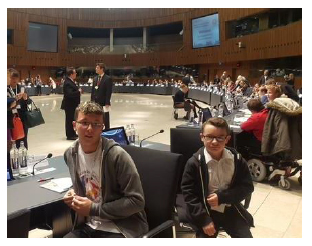
Scotland's Inclusion Ambassadors at the European Agency for Special Needs Inclusive Education Luxembourg Hearing, 2015
Since 2015 we have undertaken a significant amount of activity to address inequalities in education. Some of these are specific to children who are disadvantaged because of a protected characteristic. Some are aimed at children who are disadvantaged for another reason, such as poverty. Some happen before a child even starts school. All are aimed at achieving equity and improving educational outcomes for children and young people.
In January 2016 we launched the National Improvement Framework for Scottish Education followed by the revised National Improvement Framework and Improvement Plan in December 2016. The improvement plan now serves as the single, definitive plan for securing educational improvement and incorporates the Delivery Plan and the Curriculum for Excellence Implementation Plan published in June and September 2016 respectively.
Also, in December 2016 we published initial data on the achievement of Curriculum for Excellence ( CfE) levels [17] , based on teacher professional judgement. It shows reading, writing, listening and talking, and numeracy performance data at school, local authority and national level. Additional information on the achievement of CfE levels for individual primary stages at school level was released in January 2017. This information gives the most detailed picture ever of progress across Scotland as we work to tackle and eliminate the attainment gap between children from the most and least disadvantaged backgrounds.
Through the Children and Young People (Scotland) Act 2014 [18] , we increased funded early learning and childcare to 600 hours a year for all 3 & 4 year olds and extended this statutory entitlement to over a quarter of 2 year olds including those who are looked after, under a kinship care or guardianship order and those receiving support under the part 6 of the Immigration and Asylum Act.
We Launched Read, Write, Count in August 2015 to provide support and advice to parents of P1 to P3 children to help them get more involved in their child's literacy and numeracy learning. The universal gift packs are designed to ensure that they are as accessible as possible to all parents.
We extended the reach and scope of the Scottish Attainment Challenge. Backed by the £750 million Attainment Scotland Fund over the term of this Parliament, the Challenge prioritises improvement in key issues of literacy, numeracy, health and well-being of those children adversely affected by poverty in Scotland's primary and secondary schools. This funding includes £120m of Pupil Equity funding in 2017-18 which will be allocated directly to 95 per cent of schools and benefit every council area in Scotland.
We established the Children and Young People Improvement Collaborative ( CYPIC) which joins up the Early Years Collaborative and the Raising Attainment for All Programme to deliver quality improvement ( QI) throughout a child's journey.
We have continued a programme of work under the Developing the Young Workforce - Scotland's Youth Employment Strategy to address a number of recommendations relating to equality issues, with a focus on gender, race, disability and care leavers, in education and employment. The Developing the Young Workforce 2nd Annual Report, published in December 2016, reported significant progress including: work around the Scottish Funding Council's Gender Action plan to address, linking to schools, gender imbalances in colleges and higher education; and Skills Development Scotland's Equalities Action Plan to support more young people from diverse backgrounds to take up a Modern Apprenticeship.
We published and consulted on our draft STEM Strategy for Education and Training [19] . One of the priority themes within the Strategy is Equity - to take action to reduce equity gaps, particularly in relation to deprivation and gender. During the consultation period, we held a specific event on Women in STEM in partnership with Equate Scotland to seek new ideas on addressing gender imbalance.
We passed the Education (Scotland) Act 2016 [20] which supports a range of improvements to Scottish education including extending the rights of children with additional support needs and improving the attainment of pupils from poorer backgrounds.
We have worked with stakeholders to develop a number of key pieces of guidance for schools and local authorities aimed at improving support for children who may be disadvantaged by a protected characteristic through school education - see diagram below.
Key pieces of guidance related to support for learning and health and wellbeing duties developed since 2014
| Guidance |
Status |
|---|---|
| Published October 2014 |
|
| Conduct of Relationships, Sexual Health and Parenthood Education in Schools |
Published November 2014 |
| Guidance on the education of children unable to attend school due to ill health |
Published June 2015 |
| A National Approach to Anti-Bullying for Scotland's Children and Young People (refreshed guidance) |
Due to publish Spring 2017 |
| Included Engaged and Involved Part 2: A positive approach to preventing and managing school exclusions (refreshed guidance) |
Due to publish Spring 2017 |
| Supporting children and young people with healthcare needs in schools |
Due to publish August 2017 |
| Improving educational outcomes for children and young people from travelling cultures |
Out to public consultation |
We will continue to progress the on-going actions listed under 'Achievements' above. For example, specific actions in the National Improvement Plan include:
- We will work with Education Scotland and General Teaching Council for Scotland ( GTCS) to undertake a review of Initial Teacher Education programmes to report by April 2017, to ensure that they provide appropriate detail on content for literacy, numeracy, health and wellbeing, data literacy and equality across both primary and secondary sectors
- We will work with GTCS to provide more support to teachers on equality issues through Career Long Professional Learning to be in place by August 2017
Other actions will include:
- Through the CYPIC, supporting schools and early years services to embed Quality Improvement to make services more effective and responsive to the needs of children, young people and families. We are developing a series of Improvement Packages which cover priority policy areas such as the uptake of early learning and childcare for eligible two year olds, early literacy, attendance and exclusions and transitions from Early Learning and Childcare to primary school.
- Extending the funded entitlement to early learning and childcare to 1,140 hours a year by 2020 for 3 and 4 year olds; and, the same cohort of eligible 2 year olds; and, we are continuing to promote uptake for around a quarter of 2 year olds to the current entitlement of 600 hours.
- Responding to the National Parent Forum's review of the impact and success of the Parental Involvement Act 2006 [21] which is likely to include recommendations relating to parents and/or children with protected characteristics including gender and disability, as well as socio-economic status.
- Launching a refreshed dyslexia toolkit to support those working with pupils with dyslexia to ensure effective identification and support.
- Publishing an Equality Impact Assessment ( EQIA) for the Developing Young Workforce programme in 2017, and update it annually in line with policy developments.
- Responding to the Education and Culture Committee's recommendations on the attainment of pupil's with sensory impairment.
- Also given that evidence shows that the quality of teaching and school leadership are the most important in-school factors in a child's outcomes, further progressing our commitment to investing in the professionalism, autonomy and empowerment of our teaching profession - starting with a presumption that decisions about children's learning and school life being taken as close to the child as possible.
- Using the latest Behaviour in Scottish Schools Research findings, expected Spring 2017, to inform policy development. The latest research has been developed to provide a richer picture of relationship and behaviour issues. For example it will show how frequently teachers, head teachers and support staff deal with serious disruptive behaviour related to a protected characteristic, in the context of: abuse towards another pupil; and abuse toward a member of staff by a pupil.
Contact
Email: Nicole Ronald, Mainstreamingequality@gov.scot
Phone: 0300 244 4000 – Central Enquiry Unit
The Scottish Government
St Andrew's House
Regent Road
Edinburgh
EH1 3DG
There is a problem
Thanks for your feedback